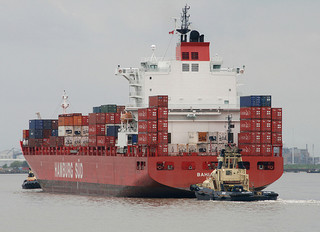 The third quarter will still be the peak season of the east-west trades for ocean carriers, but there will be no big surge in cargo volumes that will encourage significant peak season surcharges, forecasts Drewry Maritime Research.
The third quarter will still be the peak season of the east-west trades for ocean carriers, but there will be no big surge in cargo volumes that will encourage significant peak season surcharges, forecasts Drewry Maritime Research.
“The way that this year’s peak season in the northern hemisphere is shaping up, ocean carriers should not count too much on a significant revenue boost in the third quarter of 2013. All the signs are that it will be little better than last year’s disappointment,” the London-based consultancy and research firm said.
Drewry figures show that the annual container traffic shipped to the United States, Northern Europe, and the Mediterranean in the third quarter of 2012 fell for the third year running last year.
This, it added, seemed indicative that Western retailers’ usual requirement to stock up for the beginning of the school year, followed by Thanksgiving in the U.S., Christmas, and the New Year is not what it used to be.
Compared to the pre-recession days of 2004-2007, when an average 27.1 percent of each year’s total traffic was shipped from Asia to the U.S. between July and September, only 26.4 percent was shipped last year.
The proportion to Northern Europe fell from 26.8 percent to 25.7 percent, and to the Mediterranean, from 26.1 percent to 24.4 percent, respectively.
The differences may seem small, but Drewry said they suggest that “consumers’ buying patterns are changing, or traders have found a better way of meeting their needs, at a time when ocean carriers’ usually inject additional vessel capacity and container equipment.”
In other words, the seasonal transition from winter to summer cargo flows in the northern hemisphere has become more gradual, with stocking up for the summer in the second quarter gaining in importance. Garden furniture and barbeques, it seems, have replaced some of the toys and gifts usually shipped between July and September.
There are also concerns about the still many ultra-large container vessels to be delivered before year-end, for which cargo growth is a must.
Drewry said all this, as well as the supply and demand situation, is why ocean carriers are finding it difficult to be resolute with peak season surcharges.
“The TSA’s [Transpacific Stabilization Agreement] recommended increase of $400/40ft to both U.S. coasts on August 1 was only posted at the very beginning of July, for example, and very few carriers have so far even mentioned the term ‘peak season’ from Asia to Europe,” it continued.
“The US’ season also appears to have become a moveable feast, with last year’s running from 10 June, and 2011’s from 15 August.”
Instead of peak season surcharges, general rate increases (GRIs) may be the way carriers will go, as they may not find it worth the risk to provide extra vessel capacity for extra money in the peak season.
Whatever happens, “ocean carriers can no longer rely on the third quarter of each year being such a high revenue earner,” said Drewry.
In addition, the seasonal introduction of additional vessel capacity needs to be made gradual from March onwards, instead of being designed around the third quarter only.
Photo: L2F1




